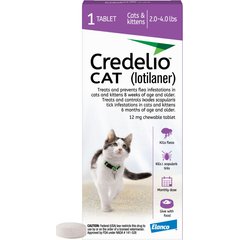Credelio for Cats (Lotilaner)
Maryviolet/iStock/Getty Images Plus via Getty Images
PetMD’s medications content was written and reviewed by veterinary professionals to answer your most common questions about how medications function, their side effects, and what species they are prescribed for. This content shouldn’t take the place of advice by your vet.
What Is Credelio Used for in Cats?
There are three types of Credelio: Credelio and Credelio Quattro for dogs, and Credelio CAT for cats. Credelio CAT is the first oral flea and tick product for cats.
The active ingredient in Credelio CAT is lotilaner. It is a small, flavored oral chewable tablet used once a month to kill and prevent adult fleas and certain tick infestations in cats.
In a 2021 effectiveness and safety study of Credelio, which was funded by the drug’s manufacturer, more than 99% of client-owned cats across the US readily ate the tablets.
Is Credelio FDA-Approved?
Yes, Credelio CAT is FDA-approved for the treatment and prevention of flea infestations for one month in cats and kittens 8 weeks of age and older and weighing 2 pounds or greater.
Credelio CAT is also FDA-approved for treatment and control of black-legged tick infestations for one month in cats and kittens 6 months of age and older and weighing 2 pounds or greater.
Speak with your veterinarian about whether Credelio CAT is right for your cat.
How Credelio Works in Cats
Credelio CAT belongs to a newer class of flea and tick preventatives called isoxazolines, which eliminate fleas and ticks by overexciting their nervous system, causing paralysis and death.
In cats, this medication works within the first few hours after administration to kill adult fleas that are present.
Credelio CAT is dosed by weight, so it is important to use the appropriate version of this medication for your cat or kitten.
How To Give Credelio to Cats
Follow the directions on the drug label or as provided by your veterinarian.
-
Credelio CAT is given by mouth once a month with a meal or within 30 minutes after feeding.
-
Give Credelio CAT year-round for the best protection against fleas and ticks.
-
Dosing is based on body weight. Your veterinarian can let you know the appropriate dose for your cat.
-
Do not use cat medications on dogs or dog medications on cats. This can cause serious problems, including a lack of efficacy or an overdose.
Missed a Dose?
Speak with your veterinarian about what to do if you forget to give a dose of Credelio CAT.
Generally, your vet may instruct you to give it when you remember and resume a monthly dosing schedule for your cat.
Do not give extra or double doses.
Fleas and ticks may temporarily be seen due to the missed treatment.
Possible Side Effects of Credelio for Cats
Credelio CAT is well tolerated in cats and has a wide safety margin. Side effects may include:
Neurologic side effects have been seen after using medications in this class of drugs (isoxazolines). Credelio should be used with caution in cats with a history of neurological disorders. Tell your veterinarian if your cat has a history of seizures or other neurologic disease.
Neurologic side effects may include:
-
Seizures
The safe use of Credelio had not yet been evaluated in breeding, pregnant, or lactating cats at the time of this publication.
Human Side Effects
Due to possible side effects, humans should never use medicine dispensed for their pets and pets should not be given any medicine dispensed for a human’s use.
If you accidentally ingest a pet medication, seek medical attention in person or call Poison Control at 800-222-1222.
Monitoring Your Pet
No specific monitoring is required for this medication, but your veterinarian may recommend routine testing depending on your cat’s individual needs, other medications they may be prescribed, and/or the issue that initially caused your cat to be placed on this medication.
When To Call Your Vet
Call your veterinarian if you see any of the following:
-
Severe side effects (above)
-
Your pet’s condition worsens or does not improve with treatment
-
You see or suspect an overdose
-
You have additional questions or concerns about the use of Credelio CAT
Credelio Overdose Concerns in Cats
Overdoses of Credelio are rare in cats. Safety studies showed that signs of a large overdose over a long period of time may include:
-
Vomiting
-
Weight loss
-
Increased blood urea nitrogen (BUN) kidney level
If you suspect an overdose, immediately contact your veterinarian, seek emergency veterinary care, or contact an animal poison control center. Consultation fees often apply.
-
Pet Poison Helpline 855-764-7661
-
ASPCA Animal Poison Control 888-426-4435
How To Store Credelio for Cats
Keep the following storage tips in mind for this medication:
-
This product should be stored at controlled temperatures between 59–77 F (15–25 C). Brief exposure to temperatures 41–104 F (5–40 C) are acceptable.
-
Keep the medication in the provided blister packs until ready to use to protect from moisture and light.
-
Keep out of reach of children and pets.
Credelio for Cats FAQs
Is Credelio safe for cats?
Yes, Credelio is safe for cats, as demonstrated in safety and efficacy studies.
How long does it take for Credelio to work on cats?
The fast-acting ingredient in Credelio starts killing adult fleas in just six hours, Credelio is rapidly absorbed, and after 24 hours it kills at least 99% of ticks and 100% of fleas for an entire month.
Can you crush Credelio for cats?
Credelio is intended to be given as a chewable tablet and not crushed. Credelio CAT was designed specifically for cats with an appealing vanilla and yeast scent and flavor.
Credelio is easy to give like a treat with a meal or within 30 minutes after feeding. Credelio can either be placed directly in your cat’s mouth or easily disguised in food.
Where can I buy Credelio for cats? And how much is it?
Credelio is available by prescription only. Work with your veterinarian to ensure the best flea/tick prevention plan for your cat’s specific needs.
Credelio CAT comes in packages containing one, three, or six chewable tablets. Check with your veterinarian or veterinary pharmacy for prices.
No vet writer or qualified reviewer has received any compensation from the manufacturer of the medication as part of creating this article. All content contained in this article is sourced from public sources or the manufacturer.


